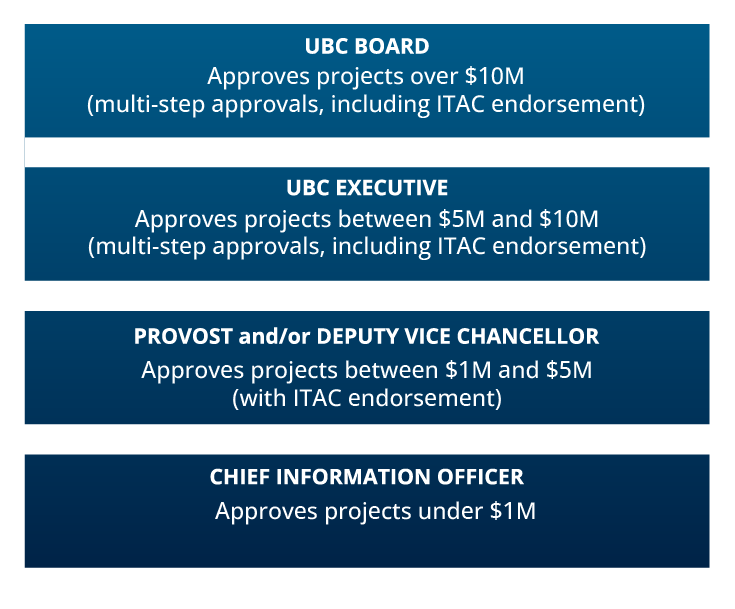Information technology is a key enabler of UBC’s teaching, learning, research, and administrative objectives and capabilities. The Office of the CIO can assist your unit when considering an investment in technology.
Contact us early to consult about your project concept. We can discuss your needs, identify existing solutions that might meet your requirements, provide guidance about potential technology costs, and determine the appropriate path to move your project forward.
All IT projects at UBC are subject to institutional governance for privacy, cybersecurity, IT, and financial investments (Policy FM11 Capital Projects and Policy FM2 Purchasing). Policy FM11 identifies the approval process that will be required for your project. We can help steward your request through the governance and the project approval process.
All IT projects at UBC are governed in accordance with the Capital Projects Policy FM11. This UBC-wide policy applies to both Building Infrastructure Development and Information Technology (IT) projects.
The purpose of the Policy is to ensure there is appropriate oversight of capital expenditures and internal loans commensurate with the value and risk associated with those activities; and to establish a framework for requests, approvals, monitoring and reporting.
The Policy applies to all IT projects regardless of size, originating unit, or availability of funding. The policy provides a definition of what constitutes an IT project, specifies approval thresholds, and identifies what must be included in the costing of an IT project.
Project approvals are governed by Policy FM11, with approval authority commensurate with the project’s Aggregate Estimated Value (AEV). The higher the project AEV the more approvals and at a higher level are required.

Aggregate Estimated Value (AEV) represents the total estimated cost of the investment. It includes both the one-time project cost and the ongoing sustainment cost for the initial term of the investment. In addition to external costs paid to vendors, AEV also includes internal costs (Administrative or Faculty staff, UBC IT staff etc.).
AEV includes:
- Purchase, license, subscription
- Work performed during planning, scoping, configuration, customization, development, implementation, and integration.
- Maintenance, support
- Contingencies, taxes
AEV is first calculated at the Investment Request stage. As the project progresses more detail will become available, the AEV will be revised and become a more accurate representation of the true cost.
The following is a high level overview of the IT Capital Planning process for investments under $5 million AEV. Investments greater than $5 million require additional approvals.
Today IT projects come in various forms and a question might come up as to what constitutes an IT project. Policy FM11 provides a definition of what is to be considered an IT project for the purpose of the policy. It includes:
- Acquisition or development of software
- Subscription fees for software-as-service (SaaS) solutions
- Acquisition of information technology hardware
- Upgrades from one major hardware or software version to another
- Associated activities and services, such as: planning, scoping, requirements gathering, installation, development, integration, configuration, and implementation related to IT.
Contact us early. The sooner you engage us, the more we can do to support you to ensure that your project is a success. Your Client Services Manager is the starting point for discussing your specific project needs and they will engage the IT Portfolio Management team and other IT experts as required.
If you do not have a Client Services Manager, or have process related questions, you can contact the IT Portfolio Management team.